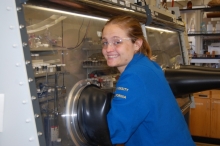
Major:
University:
Mentor(s):
Faculty Sponsor(s):
Faculty Sponsor's Department(s):
Project Title:
Project Description:
Metal hydride complexes allow researchers to better understand the bonding behavior of the metal, by studying the bond between the metal and the hydride, due to the simplicity of the hydride ligand. In particular, synthesis of elusive uranyl hydride complexes are of interest to better understand the bonding interactions of the uranyl cation ([UO2]2+), which is the major form of uranium in spent nuclear fuel. Starting materials have been synthesized in the quest for a uranyl hydride complex. Reaction of UO2Cl2(THF)2 with 2 equivalents of TPPO and 2 equivalents of KOtBu in THF produces UO2OtBu2(TPPO)2 (1) (THF = tetrahydrofuran, TPPO = triphenylphosphine oxide) as an orange solid in 68% yield. Reaction of UO2Cl2(THF)2 with 2 equivalents of TPPO and 2 equivalents of AgOAc (OAc = acetate) in dichloromethane produces [UO2(OAc)2(TPPO)]2 (2) as a yellow-green solid in 60% yield. Reaction of UO2Cl2(THF)2 with 2 equivalents of TPPO and 2 equivalents of KN(SiMe3)2 in THF produces UO2(N(SiMe3)2)2(THF)2 (3) as an orange solid in 23% yield. Reaction of 3 with 2 equivalents of TPPO in THF produces UO2(N(SiMe3)2)2(TPPO)2 (4) as a yellow solid in 30% yield. Initial reactivity studies of complexes 1-4 with Ph2SiH2, Et3SiH, pinacolborane, sodium borohydride, and LiEt3BH (also known as super hydride), monitored by 1H, 31P{1H} and 7Li{1H} NMR spectroscopy suggest that strong hydride sources, such as pinacolborane, sodium borohydride, and super hydride are required to see reactivity, although the products have yet to be fully characterized. Future work will include further characterization of the products via X-ray diffraction and reactivity studies.
